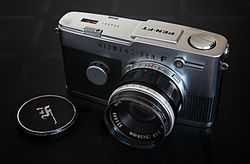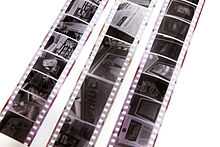Half-frame camera


A half-frame camera is a camera using a film format at half the intended exposure format. A common variety is the 18×24 mm format on regular 135 film. It is the normal exposure format on 35mm movie cameras. For still cameras using the 35mm film, the usual format is 24×36 mm, so still cameras taking 18×24 mm exposures are called half-frame cameras.
There was a vogue of half-frame cameras in the 1960s, mainly from Japan, originating with the Olympus Pen models. It allowed for a very compact camera, using commonly available film, unlike other subminiatures that used exotic films (16mm, 9.5mm, etc.). This vogue ended when cameras like the Rollei 35 or the Olympus XA showed that it was possible to make cameras as small as the half-frame ones, but taking 24×36 mm exposures.
With a half-frame camera, one can fit twice as many pictures onto a standard roll of film. For example, 72 exposures on a 36-exposure roll, 48 on a 24-exposure one, and so on. The exposures have a vertical (portrait) orientation as opposed to the horizontal (landscape) orientation of a 35mm SLR or rangefinder.
The most advanced half-frame camera that was designed as such from the start is the Yashica Samurai single lens reflex.
For some specific needs, there were cameras originally designed for full-frame pictures that were produced or custom modified in very small series as half-frame models, for example some Leica, Nikon or Robot rangefinders, and some Alpa or Minolta SLRs.[1] These are mainly of interest as collectibles.
External links
References
- ↑ A batch of 30 Minolta X-300 35mm full-frame SLRs custom modified to half-frame for the police in the Netherlands Forum article in German Minolta-Forum as of 2007]
This article was originally based on "Half-frame" in Camerapedia, retrieved at an unknown date under the GNU Free Documentation License.